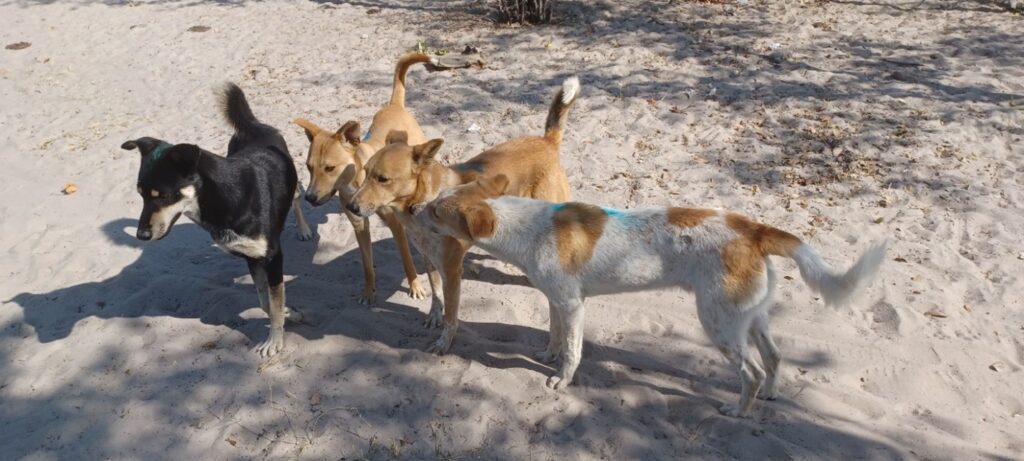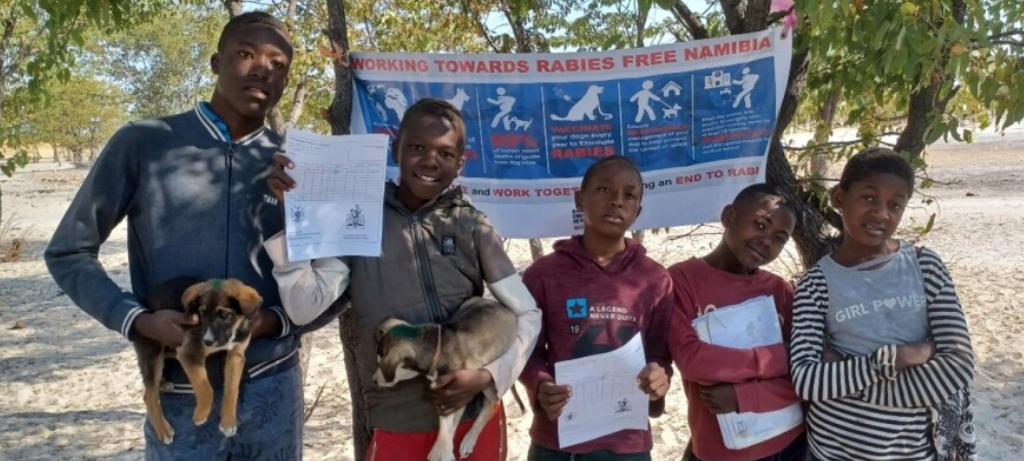Namibia’s battle against rabies: a One Health success story

In the heart of Namibia’s Northern Communal Areas (NCA), a pioneering battle is being fought against rabies. Here, veterinarians and their teams are leading the charge, utilising innovative methods and relentless dedication to significantly reduce human rabies cases, marking a remarkable achievement in the ongoing fight against this deadly disease.
Innovative vaccination campaigns
From June to July 2023, targeted dog vaccination campaigns swept through NCA’s five north central regions – Oshana, Omusati, Oshikoto, Ohangwena, and Kunene. These campaigns employed an ingenious strategy, setting up designated vaccination points to reach as many dog owners as possible. The approach was simple yet effective: create many accessible central vaccinations points where dog owners could bring their pets for rabies vaccination.
Estimating vaccination coverage in a vast and scattered settlements is a monumental challenge. The vaccination teams use a mobile app to capture and track dog vaccination data. The vaccination coverage is calculated using a dog population estimated using a human dog ratio. A capture-mark-recapture methods to estimate a vaccination coverage was also initiated in this campaign. Using this approach, dogs were marked with colored paint spray at the vaccination points, and then count the proportion of marked dogs roaming in the evening. This was logistically challenging because of the vast areas. Another method using a High-Resolution Settlement Layer (HRSL) data was employed to estimate vaccination coverage around the vaccination point.
HRSL data was leveraged to estimate human and dog populations within 2 km of the vaccination points. This data-driven method provided a feasible alternative when conventional surveys were impractical in Namibia’s challenging field settings.

Getting results in the face of multifaceted challenges
At one vaccination point, where 74 dogs were vaccinated, HRSL data estimated a dog population of 115, resulting in a vaccination coverage of 64%. Meanwhile, an owner survey suggested a coverage of 86%. These figures highlighted the complexities of estimating coverage, as not all dog owners participated in the vaccination campaign.
In another nearby point, the team vaccinated 70 dogs, with HRSL estimating a dog population of 93 and a coverage of 75%, while the dog owner survey estimated a coverage of 78%. These findings demonstrated the potential application of HRSL data to estimate coverage in challenging field settings.
However, challenges persisted. Lack of transport and human resources to form enough vaccination teams were notable hurdles to cover large number of vaccination points. Throughout the campaign, several observations stood out. Schoolchildren played a crucial role in bringing dogs to vaccination points, capitalising on the fact that the campaign occurred during school holidays. The team vaccinated 40,286 pets. However, some dog owners remained unaware of the schedule, emphasizing the importance of communication.
The rapid dog population turnover, with many puppies and juveniles (>50%), presented to the vaccination points underscored the need for annual vaccination campaigns to maintain the herd immunity. Rabies education at the vaccination points was a significant success, thanks to banners and posters distributed by the World Organisation for Animal Health (WOAH) subregional representation for Southern Africa.

Namibia integrates rabies vaccinations in dogs with cattle vaccination for foot-and-mouth disease (FMD) and contagious bovine pleuropneumonia (CBPP) at the cattle crushpens, where the pet owners also bring their pets at the crushpens for rabies vaccination. This approach improves coverage by reaching more remote locations in NCA.
A brighter future in Namibia’s battle against rabies
As the world celebrates World Rabies Day, Namibia’s success story stands as a shining example of the impact that dedicated individuals can have in the fight against rabies.
Namibia’s battle against rabies showcased the power of a One Health approach. From government leadership to community involvement, the nation’s strategy not only reduced human rabies cases from around 25 deaths in 2015 to 7 cases in 2022 but also improved data-sharing and Veterinary Services.
By endorsing the country’s National Rabies Control Strategy, WOAH validated Namibia’s commitment, leading to sustained support and to further implement their control programme.
In the vast and scattered settlements of Namibia’s NCA, the frontline rabies fighters continue their mission, safeguarding both human and animal lives, one vaccination at a time. Their dedication serves as a beacon of hope in the relentless fight against this deadly disease.
The rabies elimination programme is co-funded by the Federal Ministry for Economic Cooperation and Development (BMZ) and implemented by the Directorate of Veterinary Services with technical support provided by the World Organisation for Animal Health (WOAH) and the Friedrich-Loeffler-Institut (FLI).
Learn more on how to tackle rabies
-
Rabies web portal
-
Global Strategic Plan to end human deaths from dog-mediated rabies by 2030
-
Poster on responsible dog ownership
-
Factsheet on dog population management
